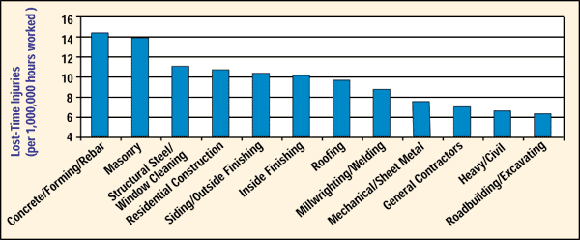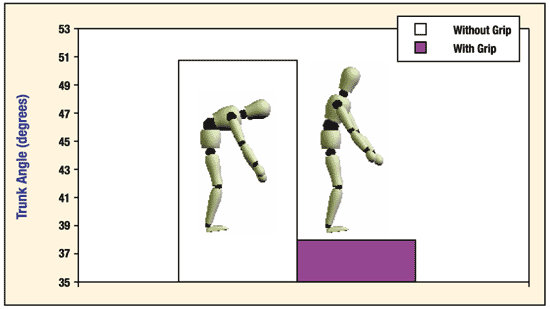Summary Statement
Describes a study of masons comparing the use of standard and lightweight block and the impact on musculoskeletal disorders. Concludes that injuries can be reduced with lightweight block.
Winter 2000/2001
Better design of concrete blocks can reduce risk of injury
|
The
major concerns with current blocks are awkwardness and weight.
|
Workers in the masonry trade have experienced higher than average musculoskeletal disorders (MSDs).
Among all construction rate groups, masonry is one of the highest risk groups for non-traumatic MSDs of the back, shoulders, arms, and legs.
As shown in Figure 1, the masonry trade had an average MSD incidence rate of 14.0 per million hours worked from 1994 to 1998, as compared to an overall construction average of 8.1 per million hours worked.
These injuries in the masonry trade are due, in part, to repetitive handling of concrete blocks.
Standard blocksIn 1999, at the request of the Ontario Masonry Contractors Association, CSAO and the Workplace Safety and Insurance Board analyzed masonry activities to determine their potential for causing MSDs.
The study revealed that working with standard concrete blocks--each measuring 12 x 24 x 6 inches and weighing 35-45 pounds--can expose workers to a high risk of low-back injury.
The major concerns with these blocks are awkwardness and weight. Based on the study, two recommendations were made to reduce the risk of MSDs for masonry workers:
1) decrease the weight of standard concrete blocks
2) add handles or grips to the blocks.
Recently CSAO evaluated a new concrete block design formed with grips at both ends (Figure 2).
ExperimentTo evaluate the effectiveness of concrete blocks with reduced weight and molded grips, four mason apprentices and one mason journeyman participated in an experiment. They were asked to perform simulated block-laying tasks using two blocks weighing approximately 20 kg each--one with grips and one without. After each experimental trial, the participants were allowed a 10-minute rest period before starting another trial. In total, each trial required the participants to perform eight repetitive lifting and eight controlled lowering activities.
ConclusionsResults demonstrated that lightening the block and adding grips not only decreases the load on the lower back (Figure 3) but also reduces awkward posture (Figure 4).
Based on these findings, CSAO concluded that the new lighter-weight block with molded grips is safer and easier to handle than the old design with no grips and more weight.
Given the potential benefits of the proposed design, CSAO has recommended further research and development with the cooperation of manufacturers, contractors, and Ontario's Masonry and Allied Trades Labour-Management Health and Safety Committee.
Figure 1: Non-traumatic musculoskeletal injury by construction rate group (WSIB Data: 1994-1998)
Lighter blocks with grips decrease load and reduce awkward posture.
Figure 3: Mean low-back moment while participants lift solid concrete block. A "moment" is defined as the tendency of a force applied to an object to cause the object to rotate, twist or bend about a point, axle or axis. The higher the moment of force, the higher the stress on the lower back.
Figure 4: Mean trunk bending posture at the instant when the participants lift the solid concrete blocks. Higher trunk angle indicates that the workers have to bend or lean forward a greater distance.




